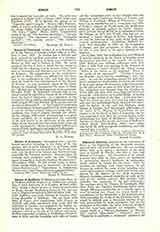

Simon of Sudbury, Archbishop of Canterbury, b. at Sudbury, Suffolk, England, of middle class parents, date of birth unknown; d. at London, June 14, 1381. After taking a degree in law at Paris, he proceeded to Rome, became chaplain to Innocent VI, and was sent to England as nuncio to Edward III in 1356. In 1361 Sudbury was made Bishop of London, after being chancellor of Salisbury. He was busy with John of Gaunt over negotiations with France in 1372-78, and while complaints were made that his cathedral in London was neglected, the bishop enriched his native town by building and endowing a collegiate church on the site of his father’s old house. Sudbury succeeded Langham as Archbishop of Canterbury in 1375, and his friendship with John of Gaunt and the Lancastrian party at once brought him into opposition with Courtenay, Bishop of London, and William of Wykeham, Bishop of Winchester. Sudbury was an amiable but not a strong man, and John of Gaunt’s support of Wyclif made the archbishop reluctant to proceed against the latter. Courtenay’s pressure forced Wyclif to be summoned before the bishops in 1377, but Wyclif, who had not yet incurred a formal charge of heresy, had Lancaster and the influence of the court at his back, and escaped condemnation. Archbishop Sudbury became Lord Chancellor in 1380, on the resignation of Scrope, and this acceptance of office cost him his life a year later at the great uprising of the peasants.
On June 11, 1381, the archbishop was with Richard II and his ministers in the Tower of London, when the peasants marched on the capital. On June 14, while Richard was holding conference with Wat Tyler at Mile End, and agreeing to the demands of the peasants, a crowd invaded the Tower crying “Where is the traitor to the kingdom? Where is the spoiler of the commons?” “Neither a traitor, nor despoiler am I, but thy archbishop”, came the reply. In vain the archbishop warned the mob that heavy punishment would follow his death; the hatred of the people against all whom they judged responsible for the polltax left no room in their hearts for mercy. The archbishop was dragged from his chamber to Tower Hill, and there with many blows his head was struck off—to be placed on London Bridge, according to the savage custom of the time. A few days later, when the rising was over, the head was taken down, and, with the archbishop’s body, removed to Canterbury for burial. It was said that Sudbury, when Bishop of London, had discouraged pilgrimages to the shrine of St. Thomas at Canterbury; he was known to be the friend of John of Lancaster, and he had imprisoned John Ball, the peasant leader, as his predecessors had done, at Maidstone. But the fact that he was chancellor was the real cause of Sudbury’s violent death. Nevertheless, there were many who loved the mild and gentle archbishop, and who counted him a martyr.
JOSEPH CLAYTON

